如何写英语文献综述
- 格式:doc
- 大小:42.00 KB
- 文档页数:3
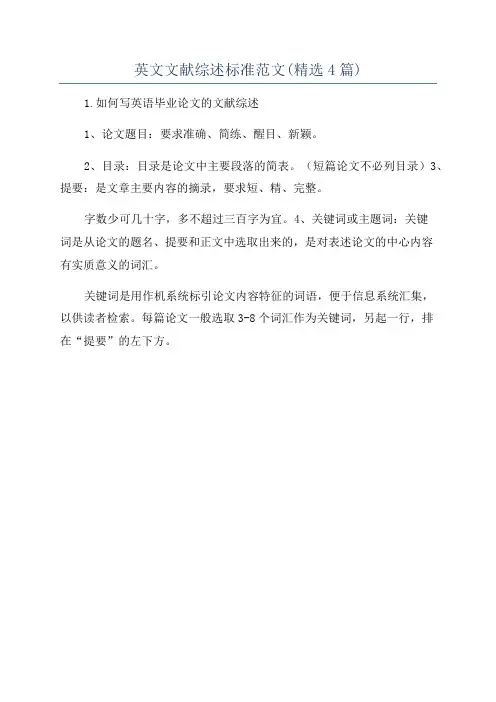
英文文献综述标准范文(精选4篇)
1.如何写英语毕业论文的文献综述
1、论文题目:要求准确、简练、醒目、新颖。
2、目录:目录是论文中主要段落的简表。
(短篇论文不必列目录)
3、提要:是文章主要内容的摘录,要求短、精、完整。
字数少可几十字,多不超过三百字为宜。
4、关键词或主题词:关键
词是从论文的题名、提要和正文中选取出来的,是对表述论文的中心内容
有实质意义的词汇。
关键词是用作机系统标引论文内容特征的词语,便于信息系统汇集,
以供读者检索。
每篇论文一般选取3-8个词汇作为关键词,另起一行,排
在“提要”的左下方。
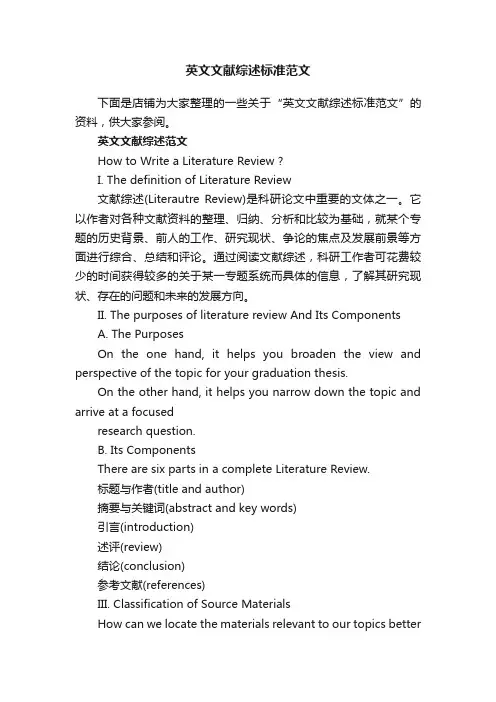
英文文献综述标准范文下面是店铺为大家整理的一些关于“英文文献综述标准范文”的资料,供大家参阅。
英文文献综述范文How to Write a Literature Review ?I. The definition of Literature Review文献综述(Literautre Review)是科研论文中重要的文体之一。
它以作者对各种文献资料的整理、归纳、分析和比较为基础,就某个专题的历史背景、前人的工作、研究现状、争论的焦点及发展前景等方面进行综合、总结和评论。
通过阅读文献综述,科研工作者可花费较少的时间获得较多的关于某一专题系统而具体的信息,了解其研究现状、存在的问题和未来的发展方向。
II. The purposes of literature review And Its ComponentsA. The PurposesOn the one hand, it helps you broaden the view and perspective of the topic for your graduation thesis.On the other hand, it helps you narrow down the topic and arrive at a focusedresearch question.B. Its ComponentsThere are six parts in a complete Literature Review.标题与作者(title and author)摘要与关键词(abstract and key words)引言(introduction)述评(review)结论(conclusion)参考文献(references)III. Classification of Source MaterialsHow can we locate the materials relevant to our topics betterand faster? Basically, all these source materials may be classified into four majors of sources.A: Background sources:Basic information which can usually be found in dictionaries andencyclopedia complied by major scholars or founders of the field. Three very good and commonly recommenced encyclopedias are encyclopedias ABC, namely, Encyclopedia Americana, Encyclopedia Britannica, and Collier’s Encyclopedia. There are also reference works more specialized, such as The Encyclopedia of Language and Linguistics for linguistics and TEFL studies. Moreover, you may also find Encyclopedia on the web.B: Primary sourcesThose providing direct evidence, such as works of scholars of the field,biographies or autobiographies, memoirs, speeches, lectures, diaries, collection of letters, interviews, case studies, approaches, etc. Primary sources come in various shapes and sizes, and often you have to do a little bit of research about the source to make sure you have correctly identified it. When a first search yields too few results, try searching by broader topic; when a search yields toomany results, refine your search by narrowing down your search.C: Secondary sourcesThose providing indirect evidence, such as research articles or papers, bookreviews, assays, journal articles by experts in a given field, studies on authors orwriters and their works, etc. Secondary sources will informmost of your writingin college. You will often be asked to research your topic using primary sources,but secondary sources will tell you which primary sources you should use andwill help you interpret those primary sources. T o use theme well, however, youneed to think critically them. There are two parts of a source that you need toanalyze: the text itself and the argument within the text.D: Web sourcesThe sources or information from websites. Web serves as an excellentresource for your materials. However, you need to select and evaluate Websources with special care for very often Web sources lack quality control. Youmay start with search engines, such as Google, Yahoo, Ask, Excit e, etc. It’s agood idea to try more than one search engine, since each locates sources in itsown way. When using websites for information, be sure to take care for theauthorship and sponsorship. If they are both unclear, be critical when you useinformation. The currency of website information should also be taken intoaccount. Don’t use too out information dated for your purpose.IV. Major strategies of Selecting Materials for literaturereviewA. Choosing primary sources rather than secondary sourcesIf you have two sources, one of them summarizing or explaining a work andthe other the work itself, choose the work itself. Never attempt to write a paperon a topic without reading the original source.B. Choosing sources that give a variety of viewpoints on your thesisRemember that good argument essays take into account counter arguments.Do not reject a source because it makes an argument against you thesis.C. Choosing sources that cover the topic in depthProbably most books on Communicative Language Teaching mention WilliamLittlewood, but if this your topic, you will find that few sources cover the topicin depth. Choose those.D. Choosing sources written by acknowledged expertsIf you have a choice between an article written by a freelance journalist onTask-based Teaching and one written by a recognized expert like David Nunan,Choose the article by the expert.E. Choosing the most current sourcesIf your topic involves a current issue or social problem or development in ascientific field, it is essential to find the latest possible information. If all thebooks on these topics are rather old, you probably need to look for information inperiodicals.V. Writing a literature ReviewA. When you review related literature, the major review focuses should be:1. The prevailing and current theories which underlie the research problem.2. The main controversies about the issue, and about the problem.3. The major findings in the area, by whom and when.4. The studies which can be considered the better ones, and why.5. Description of the types of research studies which can provide the basis for the current theories and controversies.6. Criticism of the work in the area.B. When you write literature review, the two principles to follow are:1. Review the sources that are most relevant to your to your thesis.2. Describe or write your review as clear and objective as you can.C. Some tips for writing the review:1. Define key terms or concepts clearly and relevant to your topic.2. Discuss the least-related references to your question first and the mostrelated references last.3. Conclude your review with a brief summary.4. Start writing your review early.VI. 文献综述主要部分的细节性提示和注意事项主要部分细节提示:引言(Introduction)引言是文献综述正文的开始部分,主要包括两个内容:一是提出问题;二是介绍综述的范围和内容。
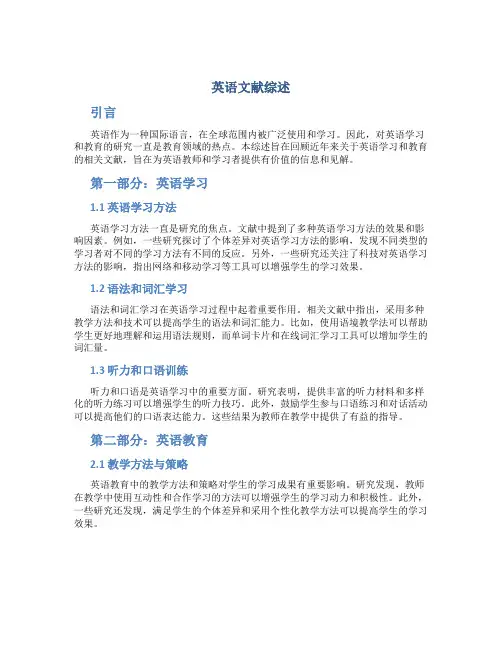
英语文献综述引言英语作为一种国际语言,在全球范围内被广泛使用和学习。
因此,对英语学习和教育的研究一直是教育领域的热点。
本综述旨在回顾近年来关于英语学习和教育的相关文献,旨在为英语教师和学习者提供有价值的信息和见解。
第一部分:英语学习1.1 英语学习方法英语学习方法一直是研究的焦点。
文献中提到了多种英语学习方法的效果和影响因素。
例如,一些研究探讨了个体差异对英语学习方法的影响,发现不同类型的学习者对不同的学习方法有不同的反应。
另外,一些研究还关注了科技对英语学习方法的影响,指出网络和移动学习等工具可以增强学生的学习效果。
1.2 语法和词汇学习语法和词汇学习在英语学习过程中起着重要作用。
相关文献中指出,采用多种教学方法和技术可以提高学生的语法和词汇能力。
比如,使用语境教学法可以帮助学生更好地理解和运用语法规则,而单词卡片和在线词汇学习工具可以增加学生的词汇量。
1.3 听力和口语训练听力和口语是英语学习中的重要方面。
研究表明,提供丰富的听力材料和多样化的听力练习可以增强学生的听力技巧。
此外,鼓励学生参与口语练习和对话活动可以提高他们的口语表达能力。
这些结果为教师在教学中提供了有益的指导。
第二部分:英语教育2.1 教学方法与策略英语教育中的教学方法和策略对学生的学习成果有重要影响。
研究发现,教师在教学中使用互动性和合作学习的方法可以增强学生的学习动力和积极性。
此外,一些研究还发现,满足学生的个体差异和采用个性化教学方法可以提高学生的学习效果。
2.2 评估与反馈评估和反馈对于英语教育的有效性至关重要。
文献中指出,采用多样化的评估方法和及时的反馈可以帮助学生了解自己的学习进展,并做出相应的调整。
此外,一些研究还提出了使用技术工具进行教学评估的方法,以提高评估效果和效率。
2.3 教材与资源教材与资源是英语教育中不可或缺的一部分。
研究表明,使用多样化的教材和资源可以激发学生的学习兴趣和提高学习效果。
此外,一些研究还提倡利用科技和网络资源来增强教学内容和教学方法。
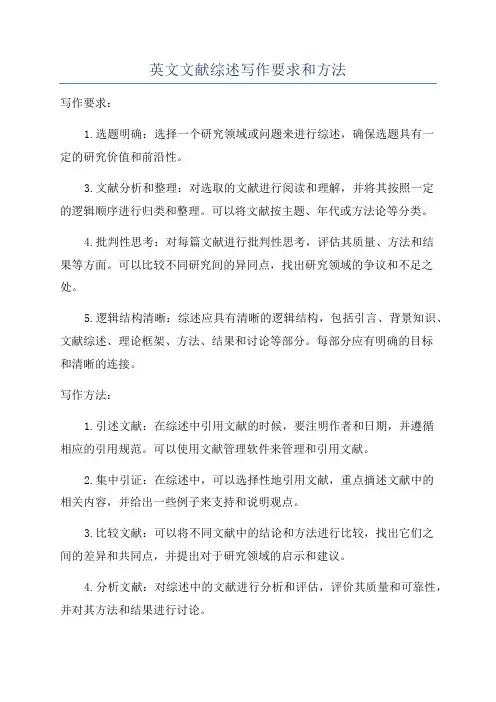
英文文献综述写作要求和方法
写作要求:
1.选题明确:选择一个研究领域或问题来进行综述,确保选题具有一
定的研究价值和前沿性。
3.文献分析和整理:对选取的文献进行阅读和理解,并将其按照一定
的逻辑顺序进行归类和整理。
可以将文献按主题、年代或方法论等分类。
4.批判性思考:对每篇文献进行批判性思考,评估其质量、方法和结
果等方面。
可以比较不同研究间的异同点,找出研究领域的争议和不足之处。
5.逻辑结构清晰:综述应具有清晰的逻辑结构,包括引言、背景知识、文献综述、理论框架、方法、结果和讨论等部分。
每部分应有明确的目标
和清晰的连接。
写作方法:
1.引述文献:在综述中引用文献的时候,要注明作者和日期,并遵循
相应的引用规范。
可以使用文献管理软件来管理和引用文献。
2.集中引证:在综述中,可以选择性地引用文献,重点摘述文献中的
相关内容,并给出一些例子来支持和说明观点。
3.比较文献:可以将不同文献中的结论和方法进行比较,找出它们之
间的差异和共同点,并提出对于研究领域的启示和建议。
4.分析文献:对综述中的文献进行分析和评估,评价其质量和可靠性,并对其方法和结果进行讨论。
5.提出研究问题:综述中可以提出一些未解决的问题或者待研究的方向,以促进进一步的研究和探索。
综述的写作并不是简单地列出已有文献的摘要,而是要对相关研究进行整体性的分析和综合。
写作过程中要做到客观、准确和批判性思考,以提供一个对该领域最新进展的全面了解。
最后,总结整理已有研究的基础上,可以对未来的研究方向进行一定的展望。
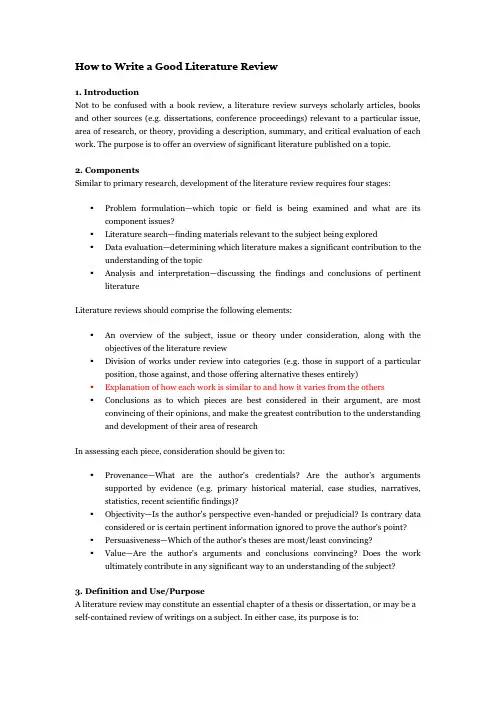
How to Write a Good Literature Review1. IntroductionNot to be confused with a book review, a literature review surveys scholarly articles, books and other sources (e.g. dissertations, conference proceedings) relevant to a particular issue, area of research, or theory, providing a description, summary, and critical evaluation of each work. The purpose is to offer an overview of significant literature published on a topic.2. ComponentsSimilar to primary research, development of the literature review requires four stages:▪Problem formulation—which topic or field is being examined and what are its component issues?▪Literature search—finding materials relevant to the subject being explored▪Data evaluation—determining which literature makes a significant contribution to the understanding of the topic▪Analysis and interpretation—discussing the findings and conclusions of pertinent literatureLiterature reviews should comprise the following elements:▪An overview of the subject, issue or theory under consideration, along with the objectives of the literature review▪Division of works under review into categories (e.g. those in support of a particular position, those against, and those offering alternative theses entirely) ▪Explanation of how each work is similar to and how it varies from the others▪Conclusions as to which pieces are best considered in their argument, are most convincing of their opinions, and make the greatest contribution to the understanding and development of their area of researchIn assessing each piece, consideration should be given to:▪Provenance—What are the author's credentials? Are the author's arguments supported by evidence (e.g. primary historical material, case studies, narratives, statistics, recent scientific findings)?▪Objectivity—Is the author's perspective even-handed or prejudicial? Is contrary data considered or is certain pertinent information ignored to prove the author's point?▪Persuasiveness—Which of the author's theses are most/least convincing?▪Value—Are the author's arguments and conclusions convincing? Does the work ultimately contribute in any significant way to an understanding of the subject?3. Definition and Use/PurposeA literature review may constitute an essential chapter of a thesis or dissertation, or may be a self-contained review of writings on a subject. In either case, its purpose is to:▪Place each work in the context of its contribution to the understanding of the subject under review▪Describe the relationship of each work to the others under consideration▪Identify new ways to interpret, and shed light on any gaps in, previous research▪Resolve conflicts amongst seemingly contradictory previous studies▪Identify areas of prior scholarship to prevent duplication of effort▪Point the way forward for further research▪Place one's original work (in the case of theses or dissertations) in the context of existing literatureHere are some of the questions your literature review should answer:1.What do we already know in the immediate area concerned?2. What are the characteristics of the key concepts or the main factors or variables?2.What are the relationships between these key concepts, factors or variables?3.What are the existing theories?4.Where are the inconsistencies or other shortcomings in our knowledge andunderstanding?5.What views need to be (further) tested?6.What evidence is lacking, inconclusive, contradictory or too limited?7.Why study (further) the research problem?8.What contribution can the present study be expected to make?9. What research designs or methods seem unsatisfactory?HOW CAN I WRITE A GOOD LITERATURE REVIEW?Remember the purpose: it should answer the questions we looked at above. Look at how published writers review the literature. You'll see that you should use the literature to explain your research - after all, you are not writing a literature review just to tell your reader what other researchers have done. You aim should be to show why your research needs to be carried out, how you came to choose certain methodologies or theories to work with, how your work adds to the research already carried out, etc.Read with a purpose:you need to summarize the work you read but you must also decide which ideas or information are important to your research (so you can emphasize them), and which are less important and can be covered briefly or left out of your review. You should also look for the major concepts, conclusions, theories, arguments etc. that underlie the work, and look for similarities and differences with closely related work. This is difficult when you first start reading, but should become easier the more you read in your area.Write with a purpose: your aim should be to evaluate and show relationships between the work already done (Is Researcher Y's theory more convincing than Researcher X's? DidResearcher X build on the work of Researcher Y?) and between this work and your own. In order to do this effectively you should carefully plan how you are going to organize your work.A lot of people like to organize their work chronologically (using time as their organizing system). Unless developments over time are crucial to explain the context of your research problem, using a chronological system will not be an effective way to organize your work. Some people choose to organize their work alphabetically by author name: this system will not allow you to show the relationships between the work of different researchers, and your work, and should be avoided!When you read for your literature review, you are actually doing two things at the same time (which makes things more difficult for you!):1. you are trying to define your research problem: finding a gap, asking a question,continuing previous research, counter-claiming;2. you are trying to read every source relevant to your research problem.Naturally, until you have defined your problem, you will find that there are hundreds of sources that seem relevant. However, you cannot define your problem until you read around your research area. This seems a vicious circle, but what should happen is that as you read you define your problem, and as you define your problem you will more easily be able to decide what to read and what to ignore.TRAPSSome traps to avoid:Trying to read everything! As you might already have discovered, if you try to be comprehensive you will never be able to finish the reading! The idea of the literature review is not to provide a summary of all the published work that relates to your research, but a survey of the most relevant and significant work.Reading but not writing! It's easier to read than to write: given the choice, most of us would rather sit down with a cup of coffee and read yet another article instead of putting ourselves in front of the computer to write about what we have already read! Writing takes much more effort, doesn't it? However, writing can help you to understand and find relationships between the work you've read, so don't put writing off until you've "finished" reading - after all, you will probably still be doing some reading all the way through to the end of your research project. Also, don't think of what you first write as being the final ornear-final version. Writing is a way of thinking, so allow yourself to write as many drafts as you need, changing your ideas and information as you learn more about the context of your research problem.Not keeping bibliographic information!The moment will come when you have to write your references page . . . and then you realize you have forgotten to keep the information you need, and that you never got around to putting references into your work. The only solution is to spend a lot of time in the library tracking down all those sources that you read, and going through your writing to find which information came from which source. If you're lucky, maybe you can actually do this before your defence - more likely, you will unable to find all your sources, a big headache for you and your committee. To avoid this nightmare, always keep this information in your notes. Always put references into your writing. Notice how on this course we have referenced the works that we have referred to - you should do the same.LITERATURE REVIEW: AN EXAMPLEHere is an example of using the literature to explain and define a problem. This example is taken from an introduction because most thesis literature reviews tend to be too long for us to easily look at. Although your literature review will probably be much longer than the one below, it is useful to look at the principles the writers have used.On the optimal container size in automated warehousesY. Roll, M.J. Rosenblatt and D. Kadosh, Proceedings of the NinthICPRAutomated storage and retrieval systems (AS/RS) are being introduced intothe industry and warehousing at an increasing rate. Forecasts indicate thatthis trend will continue for the foreseeable future (see [1]). Research in thearea of AS/RS has followed several avenues. Early work by Hausman,Schwarz and Graves [6, 7] was concerned with storage assignment andinterleaving policies, based on turnover rates of the various items. Elsayed [3]and Elsayed and Stern [4] compared algorithms for handling orders inAR/RS. Additional work by Karasawa et al. [9], Azadivar [2] and Parry et al.[11] deals with the design of an AS/RS and the determination of itsthroughput by simulation and optimization techniques.Several researchers addressed the problem of the optimal handling unit(pallet or container) size, to be used in material handling and warehousingsystems. Steudell [13], Tanchoco and Agee[14], Tanchoco et al. [15] andGrasso and Tanchoco [5] studied various aspects of this subject. The last tworeferences incorporate the size of the pallet, or unit load, in evaluation of theoptimal lot sizes for multi-inventory systems with limited storage space. In areport on a specific case, Normandin [10] has demonstrated that using the'best-size' container can result in considerable savings. A simulation modelcombining container size and warehouse capacity considerations, in anAS/RS environment, was developed by Kadosh [8]. The general results,reflecting the stochastic nature of the flow of goods, are similar to thosereported by Rosenblatt and Roll [12]. Nevertheless, container size was foundto affect strongly overall warehousing costs.In this paper, we present an analytical framework for approximating theoptimal size of a warehouse container. The approximation is based on seriesof generalizations and specific assumptions. However, these are valid for awide range of real life situations. The underlying assumptions of the modelare presented in the following section.Notice how the writers have:grouped similar information: "Steudell [13], Tanchoco and Agee[14], Tanchoco et al. [15] and Grasso and Tanchoco [5] studied various aspects of this subject."shown the relationship between the work of different researchers, showingsimilarities/differences: "The general results, reflecting the stochastic nature of the flow of goods, are similar to those reported by Rosenblatt and Roll [12]."indicated the position of the work in the research area history: "Early work by Hausman, Schwarz and Graves [6, 7] . . . "moved from a general discussion of the research in AS/RS to the more specific area (optimal container size) that they themselves are researching i.e. they relate previous work to their own to define it, justify it and explain it.。
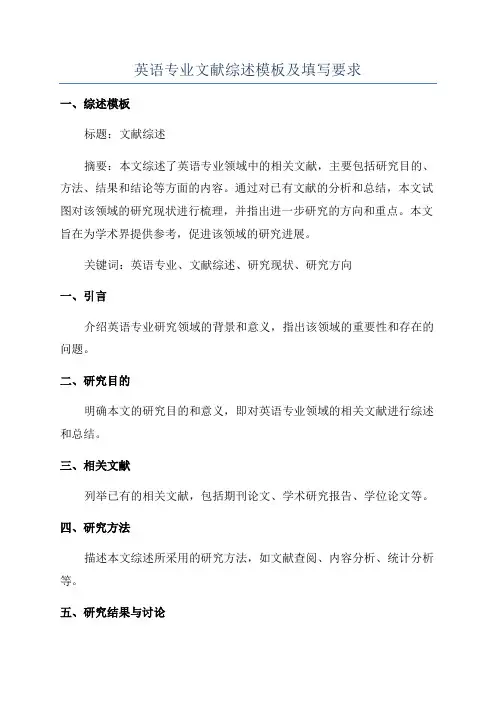
英语专业文献综述模板及填写要求一、综述模板标题:文献综述摘要:本文综述了英语专业领域中的相关文献,主要包括研究目的、方法、结果和结论等方面的内容。
通过对已有文献的分析和总结,本文试图对该领域的研究现状进行梳理,并指出进一步研究的方向和重点。
本文旨在为学术界提供参考,促进该领域的研究进展。
关键词:英语专业、文献综述、研究现状、研究方向一、引言介绍英语专业研究领域的背景和意义,指出该领域的重要性和存在的问题。
二、研究目的明确本文的研究目的和意义,即对英语专业领域的相关文献进行综述和总结。
三、相关文献列举已有的相关文献,包括期刊论文、学术研究报告、学位论文等。
四、研究方法描述本文综述所采用的研究方法,如文献查阅、内容分析、统计分析等。
五、研究结果与讨论对已有文献进行分析和总结,总结该领域的研究现状,包括已取得的成果、存在的问题和不足之处等。
六、研究的局限性七、研究的进展和展望提出该领域进一步研究的方向和重点,为学者们提供参考和启示,推动该领域的研究进展。
八、结论总结本文综述的主要内容,强调研究的重要性和意义,呼吁学者们重视该领域的研究。
二、填写要求1.精确查找并引用相关文献,确保论述的准确和可靠性。
2.文献综述要体现对目前研究现状的理解和分析,避免一味陈述已有文献的内容。
3.对已有文献进行分析和总结时,应注重对其方法和结果的评价,有利于找出其优点和不足之处。
4.综述应注意对已有文献的研究的局限性和不足之处进行描述,避免过于绝对化的态度。
5.研究的进展和展望要有针对性和可行性,避免过于宏观和空泛的表述。
6.综述要注重逻辑性和条理性,避免内容的杂乱和重复。
总的来说,英语专业文献综述要准确、全面地总结和分析相关文献的研究现状,并提出明确的进一步研究方向和重点。
通过合理的论证和论述,为学术界提供参考,推动该领域的研究进展。
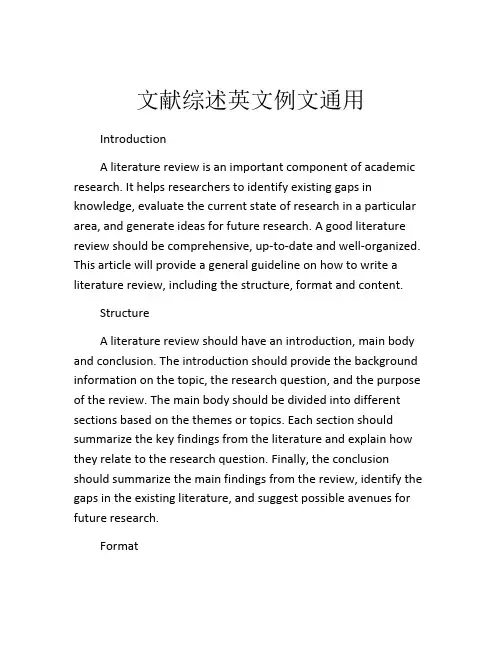
文献综述英文例文通用IntroductionA literature review is an important component of academic research. It helps researchers to identify existing gaps in knowledge, evaluate the current state of research in a particular area, and generate ideas for future research. A good literature review should be comprehensive, up-to-date and well-organized. This article will provide a general guideline on how to write a literature review, including the structure, format and content.StructureA literature review should have an introduction, main body and conclusion. The introduction should provide the background information on the topic, the research question, and the purpose of the review. The main body should be divided into different sections based on the themes or topics. Each section should summarize the key findings from the literature and explain how they relate to the research question. Finally, the conclusion should summarize the main findings from the review, identify the gaps in the existing literature, and suggest possible avenues for future research.FormatA literature review can be written in different formats depending on the discipline and the research topic. In general, there are two common formats: the narrative review and the systematic review. The narrative review is a descriptive summary of the literature, whereas the systematic review is a more rigorous evaluation of the literature using a predefined search strategy and inclusion/exclusion criteria.ContentThe content of a literature review should be focused on the research question and the themes identified in the main body. The literature reviewed should be relevant, reliable, and recent. The sources of the literature can be primary or secondary, depending on the research question and the availability of the literature. The sources can be in different forms, such as articles, books, reports, conference proceedings, and online databases.TipsHere are some tips on how to write a good literature review:- Start early: Begin the literature review as early as possible to allow sufficient time for reading, writing, and revising.- Define the research question: Clearly define the research question to guide the literature search and the selection of the literature.- Use appropriate keywords: Use appropriate keywords and search terms to identify the relevant literature.- Keep records: Keep a record of the literature searched, read and cited to avoidduplication and facilitate referencing.- Analyze and synthesize: Analyze the literature critically and synthesize the findings into a coherent and organized structure.- Avoid plagiarism: Acknowledge the sources of the literature accurately and avoid plagiarism by paraphrasing and referencing properly.- Be critical: Be critical of the literature reviewed and identify the strengths, weaknesses, and limitations of the research in the field.ConclusionIn summary, a literature review is an essential component of academic research, and it requires careful planning, organizing, and writing. A good literature review should provide a comprehensive and critical evaluation of the existing literature and identify the gaps and limitations in the research field. By following the guidelines and tips provided in this article, researchers can write a well-structured, informative and engaging literature review.。
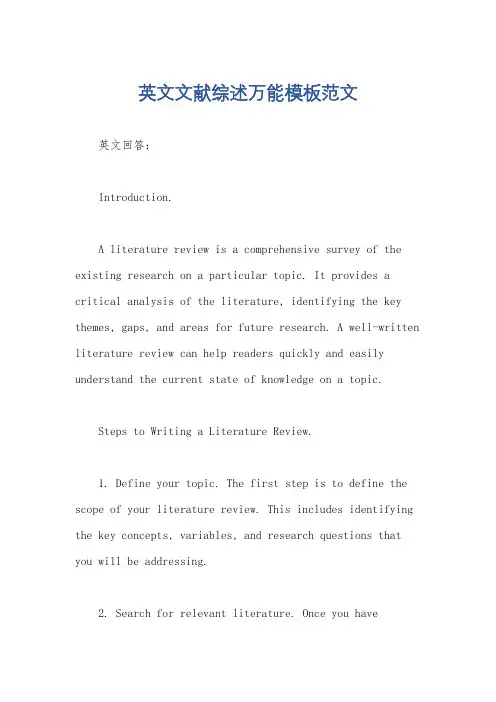
英文文献综述万能模板范文英文回答:Introduction.A literature review is a comprehensive survey of the existing research on a particular topic. It provides a critical analysis of the literature, identifying the key themes, gaps, and areas for future research. A well-written literature review can help readers quickly and easily understand the current state of knowledge on a topic.Steps to Writing a Literature Review.1. Define your topic. The first step is to define the scope of your literature review. This includes identifying the key concepts, variables, and research questions that you will be addressing.2. Search for relevant literature. Once you havedefined your topic, you need to search for relevant literature. This can be done through a variety of sources, including academic databases, Google Scholar, and library catalogs.3. Evaluate the literature. Once you have found a bodyof literature, you need to evaluate it to determine its relevance, quality, and credibility. This involves reading the abstracts and full text of the articles and assessing their strengths and weaknesses.4. Organize your review. Once you have evaluated the literature, you need to organize it into a logical structure. This may involve grouping the articles by theme, methodology, or research question.5. Write your review. The final step is to write your literature review. This should include a clear introduction, a body that discusses the key findings of the literature, and a conclusion that summarizes your findings andidentifies areas for future research.Tips for Writing a Literature Review.Be comprehensive. Include all of the relevant literature on your topic, even if it is not supportive of your hypothesis.Be critical. Evaluate the strengths and weaknesses of the literature, and identify any gaps in the research.Be clear and concise. Write in a clear and concise style, and avoid using jargon or technical language.Proofread carefully. Make sure to proofread your literature review carefully before submitting it.中文回答:文献综述的撰写步骤。
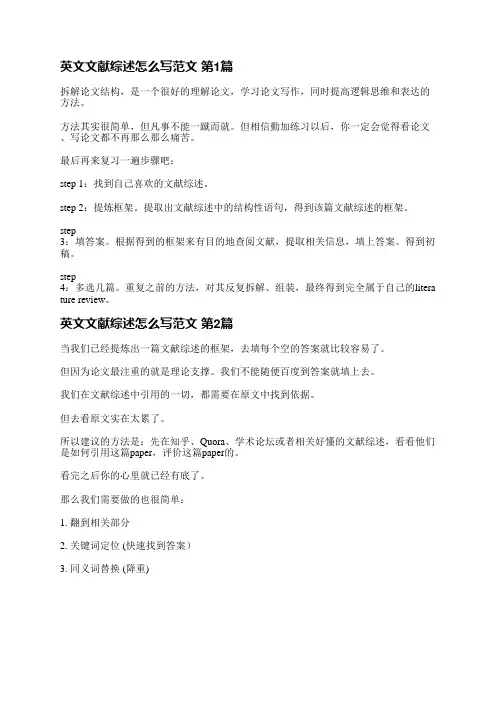
拆解论文结构,是一个很好的理解论文,学习论文写作,同时提高逻辑思维和表达的方法。
方法其实很简单,但凡事不能一蹴而就。
但相信勤加练习以后,你一定会觉得看论文、写论文都不再那么那么痛苦。
最后再来复习一遍步骤吧:step 1:找到自己喜欢的文献综述。
step 2:提炼框架。
提取出文献综述中的结构性语句,得到该篇文献综述的框架。
step3:填答案。
根据得到的框架来有目的地查阅文献,提取相关信息,填上答案。
得到初稿。
step4:多选几篇。
重复之前的方法,对其反复拆解、组装,最终得到完全属于自己的litera ture review。
英文文献综述怎么写范文第2篇当我们已经提炼出一篇文献综述的框架,去填每个空的答案就比较容易了。
但因为论文最注重的就是理论支撑。
我们不能随便百度到答案就填上去。
我们在文献综述中引用的一切,都需要在原文中找到依据。
但去看原文实在太累了。
所以建议的方法是:先在知乎、Quora、学术论坛或者相关好懂的文献综述,看看他们是如何引用这篇paper,评价这篇paper的。
看完之后你的心里就已经有底了。
那么我们需要做的也很简单:1. 翻到相关部分2. 关键词定位 (快速找到答案)3. 同义词替换 (降重)文献综述是一种通过对已有文献进行梳理、分析和评价的方法,以形成系统性的综合性文献报告,探讨某个问题的现状、发展趋势以及未来研究方向的方法。
那么如何写优秀的文献综述呢?下面从几个角度为大家介绍。
1.明确研究目的和问题在写文献综述之前,先要明确自己的研究目的和问题,这有助于你在文献中寻找和汇总符合研究方向的文献资料,也能避免收集到不必要的资料浪费时间。
2.合理筛选文献来源3.分类整理文献资料在文献综述的写作过程中,需要将搜集到的文献进行分类整理,例如按照时间、地区、专业领域、研究角度等进行整合,方便后续的分析和总结。
4.分析比较文献中不同观点和研究方法通过对文献的比较和分析,可以了解研究领域发展的趋势、发现未解决的问题和矛盾,并提出自己的新的解决方法,这就需要作家具有较强的综合分析能力。
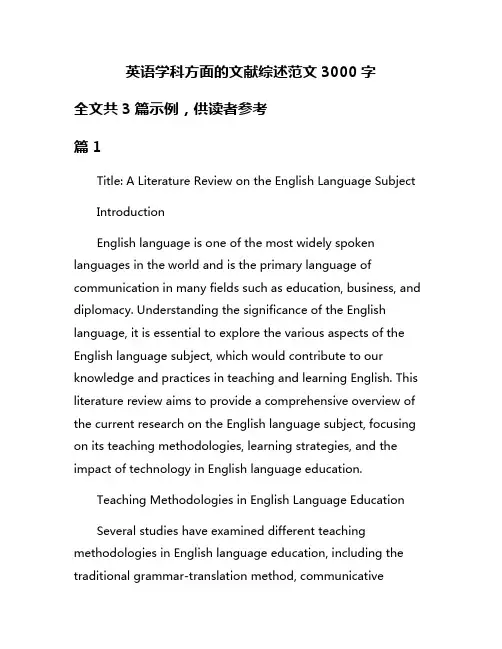
英语学科方面的文献综述范文3000字全文共3篇示例,供读者参考篇1Title: A Literature Review on the English Language SubjectIntroductionEnglish language is one of the most widely spoken languages in the world and is the primary language of communication in many fields such as education, business, and diplomacy. Understanding the significance of the English language, it is essential to explore the various aspects of the English language subject, which would contribute to our knowledge and practices in teaching and learning English. This literature review aims to provide a comprehensive overview of the current research on the English language subject, focusing on its teaching methodologies, learning strategies, and the impact of technology in English language education.Teaching Methodologies in English Language EducationSeveral studies have examined different teaching methodologies in English language education, including the traditional grammar-translation method, communicativelanguage teaching, task-based learning, and content-based instruction. The research suggests that communicative language teaching is the most effective approach to teaching English as a second language, as it focuses on real-life communication and interaction. Task-based learning has also been proven to be beneficial in English language education, as it encourages students to work on meaningful tasks that promote communication and language development.Learning Strategies in English Language EducationResearch on learning strategies in English language education has shown that students employ various strategies to enhance their language learning process. These strategies include cognitive, metacognitive, affective, and social strategies. Cognitive strategies involve the mental processes used by students to understand and remember new information, while metacognitive strategies help students monitor and regulate their own learning. Affective strategies focus on managing emotions and motivation, while social strategies involve interactions with others to improve language skills.Impact of Technology in English Language EducationWith the advancement of technology, there has been a growing interest in incorporating technology into Englishlanguage education. Research has shown that technology can enhance language learning by providing interactive and engaging learning experiences. Online resources, language learning apps, and digital tools have been used to support language learning outside the classroom and enable personalized learning experiences. Virtual reality and augmented reality technologies have also been explored to create immersive language learning environments that simulate real-life situations.ConclusionIn conclusion, this literature review has highlighted the importance of exploring the various aspects of the English language subject, including teaching methodologies, learning strategies, and the impact of technology in English language education. The research suggests that communicative language teaching is an effective approach to teaching English as a second language, while task-based learning promotes language development through meaningful tasks. Students also employ various learning strategies to enhance their language learning process, and technology has the potential to enhance language learning by providing interactive and engaging learning experiences. Further research is needed to explore innovativeapproaches to teaching and learning English language education to meet the diverse needs of learners in the 21st century.篇2Title: Literature Review on Research in English Language TeachingIntroductionEnglish language teaching has been a prominent field of study in the education sector for decades. As the world becomes more interconnected, the importance of English as a global language has increased significantly. This literature review aims to provide an overview of recent research in the field of English language teaching and explore the advancements and challenges facing educators and researchers in this area.MethodsTo conduct this literature review, a systematic search was performed using online databases such as Google Scholar, JSTOR, and ERIC. Keywords such as "English language teaching," "pedagogy," "technology," and "assessment" were used to narrow down the search results. Only peer-reviewed articles published in the last five years were included in this review.Findings1. Technology in English Language TeachingOne of the key themes that emerged from the literature review was the integration of technology in English language teaching. Researchers have explored the use of various technological tools such as online platforms, mobile apps, and virtual reality to enhance language learning. Studies have shown that technology can make learning more interactive and engaging for students, leading to improved outcomes in language acquisition.2. Task-Based LearningTask-based learning has gained popularity in recent years as a more student-centered approach to teaching English. Researchers have highlighted the benefits of using real-world tasks and activities to promote language learning and communication skills. Task-based learning has been shown to be effective in improving students' fluency, accuracy, and confidence in using English.3. Multilingualism and DiversityWith the increasing cultural diversity in classrooms, educators are exploring new strategies to support multilingualstudents in English language learning. Research has shown that embracing students' native languages and cultures can enhance their language acquisition and overall academic performance. Educators are encouraged to adopt a more inclusive approach and create a supportive environment for diverse learners.4. Assessment in English Language TeachingAssessment plays a crucial role in evaluating students' language proficiency and progress in English language teaching. Recent research has focused on innovative assessment methods such as performance tasks, portfolios, and self-assessment tools. These approaches aim to provide a more holistic view of students' language abilities and promote reflective learning practices.Challenges and Future DirectionsDespite the advancements in research in English language teaching, several challenges remain. One of the key challenges is the digital divide, where students from disadvantaged backgrounds may not have access to technology for language learning. Educators need to address this disparity and ensure equal opportunities for all students. Additionally, the growing emphasis on standardized testing in English language teachinghas raised concerns about its impact on teaching and learning outcomes.In conclusion, this literature review has highlighted the recent advancements and challenges in English language teaching research. Educators and researchers are encouraged to continue exploring innovative approaches to enhance language learning and support the diverse needs of students. By addressing the challenges and embracing new technologies, English language teaching can evolve to meet the demands of a globalized world.篇3Literature Review on the English Language Teaching FieldIntroductionEnglish language teaching is a dynamic and constantly evolving field that has undergone significant changes in recent years due to advances in technology and changes in educational practices. This literature review aims to provide an overview of current research and trends in the field of English language teaching, focusing on key topics such as language acquisition, teaching methodologies, and the use of technology in the classroom.Language AcquisitionOne of the central concerns in the field of English language teaching is the process of language acquisition. Researchers have focused on understanding how second language learners acquire English language skills and the factors that influence language learning. Studies have shown that the age at which a learner begins studying English, as well as their motivation and exposure to the language, can impact their language proficiency.Research has also explored the role of individual differences such as cognitive abilities and learning styles in language acquisition. For example, learners who have a strong auditory memory may excel in pronunciation, while those withvisual-spatial intelligence may find it easier to understand written texts. Understanding these individual differences can help educators tailor their teaching approaches to better meet the needs of diverse learners.Teaching MethodologiesTeaching methodologies play a crucial role in English language education, as they determine how language skills are taught and practiced in the classroom. Traditional teaching methods focused on grammar rules and memorization, but recent research has emphasized the importance ofcommunicative language teaching approaches that prioritize meaningful communication and real-world language use.Task-based learning, for example, is a popular approach that involves engaging students in authentic language tasks that help them develop their language skills in context. This approach encourages learners to use English to complete real-world tasks, such as giving presentations or participating in group discussions. Research has shown that task-based learning can improve students' fluency, accuracy, and confidence in using English.The use of technology in language teaching has also transformed the way English is taught in classrooms around the world. Online resources such as language learning apps, virtual classrooms, and interactive multimedia materials have made language learning more accessible and engaging for students. Research has shown that technology-enhanced language learning can improve students' motivation, engagement, and language proficiency.ConclusionIn conclusion, the field of English language teaching is a rich and diverse area of research that continues to evolve as new technologies and teaching approaches emerge. Byunderstanding key topics such as language acquisition, teaching methodologies, and the use of technology in the classroom, educators can better meet the needs of their students and promote effective language learning. Further research and collaboration among educators, researchers, and policymakers are essential to advancing the field of English language teaching and improving language education for learners worldwide.。
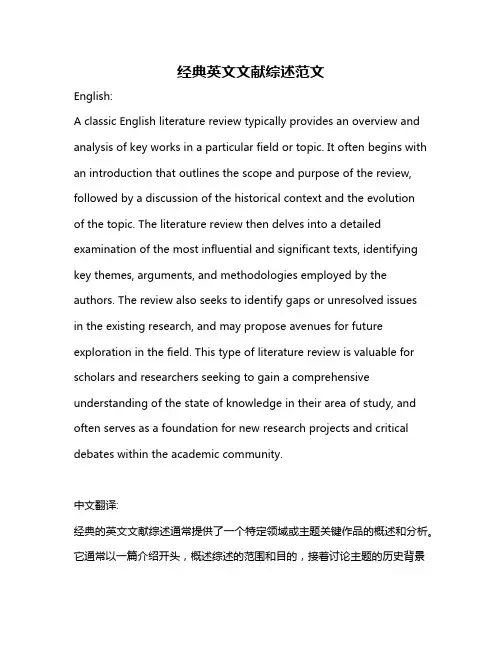
经典英文文献综述范文English:A classic English literature review typically provides an overview and analysis of key works in a particular field or topic. It often begins with an introduction that outlines the scope and purpose of the review, followed by a discussion of the historical context and the evolutionof the topic. The literature review then delves into a detailed examination of the most influential and significant texts, identifying key themes, arguments, and methodologies employed by the authors. The review also seeks to identify gaps or unresolved issuesin the existing research, and may propose avenues for future exploration in the field. This type of literature review is valuable for scholars and researchers seeking to gain a comprehensive understanding of the state of knowledge in their area of study, and often serves as a foundation for new research projects and critical debates within the academic community.中文翻译:经典的英文文献综述通常提供了一个特定领域或主题关键作品的概述和分析。
英语文献综述如何写关键词:英语文献综述中国论文论文写作指导文献综述(Literautre Review)是科研论文中重要的文体之一。
它以作者对各种文献资料的整理、归纳、分析和比较为基础,就某个专题的历史背景、前人的工作、研究现状、争论的焦点及发展前景等方面进行综合、总结和评论。
通过阅读文献综述,科研工作者可花费较少的时间获得较多的关于某一专题系统而具体的信息,了解其研究现状、存在的问题和未来的发展方向。
因此,它的学术水平和价值受到特别的重视。
文献综述往往被收集在专业期刊的Review栏目中,常见的有Survey, Advances, Progress, Recent Advances,Update 和Annual Review等。
根据写作目的和内容的侧重点,文献综述大致可以分为动态性综述(developmental review)、成就性综述(result review)和争鸣性综述(contentious review)。
按时间来划分,文献综述又可分为回顾性综述(retrospective review)和前瞻性综述(prospective review)。
根据作者的参与情况,文献综述还可分为归纳性综述(inductive review)和评论性综述(critical review)。
文献综述的分类并非绝对,在实际写作中,往往是各种类型综合在一起。
一篇结 构完整的文献综述应由六个部分组成:标题与作者(title and author)、摘要与关键词(abstract and key words)、引言(introduction)、述评(review)、结论(conclusion)和参考文献(references)。
与研究论文相比,文献综述的篇章结构比较自由,但其中最为核心的部分是引言、述评和结论。
下面将分别介绍这几个部分的特点及其写作方法。
2.1 引言(Introduction)引言是文献综述正文的开始部分,主要包括两个内容:一是提出问题;二是介绍综述的范围和内容。
英语学术写作文献综述句式英文回答:Reviewing the Literature.A literature review is a comprehensive summary and critical analysis of the relevant literature on aparticular topic. It provides an overview of the current state of knowledge on that topic and identifies gaps and areas for further research.Structure of a Literature Review.A literature review typically includes the following sections:Introduction: Introduces the topic and provides a brief overview of the existing literature.Body Paragraphs: Critically review the literature,organizing it by themes or subtopics.Synthesis: Summarizes the main findings and identifies key themes and gaps in the research.Conclusion: Summarizes the main arguments and implications of the literature review.Types of Literature Reviews.There are different types of literature reviews, depending on the purpose and scope:Systematic Review: A rigorous and comprehensive review that follows a specific methodology to identify, select, and analyze studies.Narrative Review: A more informal review that provides an overview of the literature without following a strict methodology.Meta-Analysis: A statistical analysis thatcombines the results of multiple studies to draw overall conclusions.Writing a Literature Review.When writing a literature review, it is important to:Identify Relevant Literature: Use databases and other resources to find relevant studies.Critically Evaluate Studies: Assess the quality, validity, and relevance of the studies.Organize the Review: Group studies by themes or subtopics to provide a coherent structure.Synthesize the Findings: Draw connections between studies and identify patterns and gaps in the research.Write Clearly and Concisely: Use precise language and avoid jargon.中文回答:文献综述。
Title: English Literature Review: AComprehensive PerspectiveIn the realm of academic research, the literature review serves as a critical component, particularly in the field of English literature. This paper aims to provide an extensive overview of the significant developments and trends within the discipline, drawing upon a diverse range of sources and perspectives.Firstly, it is essential to recognize the evolving nature of English literature, which has been shaped by various historical, cultural, and societal influences. The early works of Shakespeare, for instance, have been extensively analyzed for their thematic depth andlinguistic intricacies. Modern scholars continue to delve into these classics, offering fresh interpretations that resonate with contemporary audiences.Moreover, the emergence of new literary genres and movements has significantly broadened the scope of English literature. Postmodernism, for example, has challenged traditional narrative structures and perspectives, introducing elements of ambiguity and fragmentation. Thistrend has been explored in numerous studies, highlighting the diverse ways in which authors have responded to and shaped the postmodern era.Furthermore, the intersection of English literature with other disciplines, such as psychology, sociology, and anthropology, has opened up new avenues for research. The exploration of character psychology in literary texts, or the analysis of societal norms and values reflected in literature, are just a few examples of thisinterdisciplinary approach.In terms of methodologies, the literature review has also undergone significant transformations. With the advent of digital technologies and online databases, scholars now have access to vast repositories of information, enabling them to conduct more comprehensive and rigorous reviews. However, the challenge lies in effectively synthesizing and evaluating this vast amount of data.One notable trend in recent years has been the increasing focus on global perspectives in English literature. With the growth of international literary movements and the rise of multiculturalism, scholars arenow more inclined to explore the global dimensions of literary works. This approach not only broadens our understanding of English literature but also promotes cross-cultural understanding and exchange.Moreover, the impact of gender and race on English literature has also been a topic of increasing interest. The examination of how gender roles and racial identities are represented and constructed in literary texts has provided valuable insights into the complex intersections of identity, power, and representation.In conclusion, the literature review in English literature is a dynamic and evolving field that continues to shape our understanding of the discipline. By exploring diverse themes, genres, and methodologies, scholars are able to delve deeper into the rich tapestry of English literature, revealing new meanings and perspectives that resonate with our contemporary world.**英语文献综述:全面视角**在学术研究领域,文献综述是一个至关重要的组成部分,尤其在英语文学领域更是如此。
如何写好英文综述要写好英文综述,可以遵循以下步骤:1. 阅读原文:在写综述之前,确保你已经仔细阅读了相关的英文原文。
理解作者的研究目的、方法和主要发现。
2. 确定主题:确定你要写综述的主题。
你可以根据自己的研究领域或兴趣选择合适的主题。
3. 组织结构:为你的综述选择一个逻辑清晰的组织结构。
可以按照时间顺序、主题分类或重要性等方式进行组织。
4. 开头和结尾:确保你的综述有一个引人入胜的开头和一个扎实的结尾。
开头可以用介绍研究背景、问题陈述或相关统计数据等方式吸引读者。
结尾要总结你的综述,并突出重点发现或未来的研究方向。
5. 提炼要点:从原文中提取出重要的要点和结论,避免陷入细节。
你可以使用标注、摘要或笔记来帮助你提炼要点。
6. 使用正确的语法和词汇:确保你使用正确的语法和词汇表达自己的观点。
避免使用复杂的句子结构或不熟悉的词汇,以免造成理解困难。
7. 解释和分析:在综述中不仅要描述研究发现,还要解释和分析这些发现。
你可以提供自己对研究的理解或观点,但要确保能够支持你的观点。
8. 引用和引文:在综述中要引用和引用相关的研究文献,以支持你的观点。
请确保你正确引用了使用的文献,并在综述末尾提供文献目录。
9. 语言修饰:使用恰当的修饰词和连接词来增强你的综述的流畅性和连贯性。
例如,使用"however"、“moreover"、“on the other hand"等词语来引导句子间关系的转换。
10. 仔细修改和校对:在完成综述后,仔细检查和校对你的写作。
检查语法错误、逻辑性和组织结构。
可以让他人帮忙审查你的综述,并提出改进意见。
通过遵循上述步骤,你可以写出一篇有逻辑性和准确性的英文综述。
英语专业文献综述Outline(5篇)第一篇:英语专业文献综述OutlineOutline 1 Introduction 2 Literature overreview2.1 Peer review2.2 incidental vocabulary acquisition2.3 Peer evaluation and the teacher3 Design of the study4 Results4.1 Students as evaluatees4.2 Students as evaluators5 Discussion6 Conclusion第二篇:英语专业实习报告 intership report outlineOutline for Internship Report1.First PageFirst page should display: Student name and surname, internship start and finish dates, number of internship days, type of internship(production, or design and development), company/institution name.This page should be signed and stamped by the supervisor of the intern student.2.Weekly timetableA weekly timetable where each row in the table corresponding to a day in internship period.Each row should record the date, internship activity on that date.Weekly Schedule should explain the work accomplished each day of the week during the internship period and should contain:•••The department of the organization that the week was and signature of the controlling supervisor for each week The official stamp of the organization.3.A Brief Executive Summary of the InternshipA one page summary of the company/institution and a short account of the major activities carried out during the internship period.4.Table of ContentsContents of the report with page numbers, list of tables, and list of figures.5.Description of the company/institution This section should answer the following questions:5.1.What is the full title of the company/institution? Give a brief history of the company, fullmailing address and relevant web links.5.2.What is the type of ownership of the company/institution? State the main shareholders andtheir shares.5.3.What is the sector that the company/institution operates in? Specify the products and servicesproduced and offered to its customers.5.4.Who are regarded as the customers of your internship company/institution(consider the endusers, retailers, other manufacturers, employees, etc.)?5.5.Provide an organization chart of the company, along with information on the number ofemployees.5.6.Provide a list of functions performed by the mechanical engineers in the internshiporganization.6.Internship activitiesThis is the main body of your report.You should present the activities performed during the internship period.Please refer to “” document for the types of analysis and inquiries that you should be perfo rming during “Production”, and “Design and Development” internship.7.An assessment of the internship In this section you should answer the following questions7.1.What skills and qualifications you think that you havegained from the internship?7.2.What kind of responsibilities you have undertaken during the internship period?7.3.How do you think the internship will influence your future career plans?7.4.How do you think the internship activities that you carried out are correlated with yourclassroom knowledge?8.Conclusions of the reportThis section should include:• A summary of key conclusions derived from the internship experience.• General observations about the sector in which your internship company/institution operates9.Appendices and supplementary material(charts, graphs, pictures, computer codes, etc.)10.ReferencesRules for writing the internship report:••••••You do not have to provide a day-to-day diary of the internship activities.Do not write theoretical excerpts from textbooks!Describe what you exactly did there and what experiences you have gained throughout your training.The internship report should be between 15-20 pages and written to “Training Program Diary” which can be provided from the university bookstore.The internship report should be written in handwriting, and each page should contain about 25 lines.The internship report should be original, no photocopies areaccepted.You can include graphs, pictures, data, drawings, or design calculations in your report;however they should not cover more than 1/3 of the rger graphs, pictures, data, drawings, or design calculations should be given as an Appendix.第三篇:Outline 4Social Movements of the 1960sI.Background---Greensboro Sit-in(格林斯博罗静坐)On February 1, 1960, 4 freshmen from a black college in Greensboro, North Carolina(北卡罗莱纳州), sat down at a department lunch counter and ordered coffee.When refused, they continued to sit at the counter, openly defying the segregation law prevailing in the state.The next day, more students joined them.Thus began the civil rights movement(黑人民权运动), which spread from the south to the ter, this quiet “sit-in” became the major nonviolent direct action tactics to be used by black civil rights activists.*The civil rights movement, and the youth anti-war, and the women’s liberation movements had long roots in United States history.(黑人民权运动、青年反战运动以及后来的妇女解放运动都深深地植根于美国历史之中)II.Definition---One professor argues that “a social movement is a type of behavior in which a large number of participants consciously attempt to change existing institutions and establish a new order of life.”---Two basic characteristics of all social movements: “structure”(有组织)and “spontaneity”(自发性)---Other necessary parts of a social movement are:1.a social base of people 人这一社会基础2.a “message” or ideology 思想体系3.the ability to spread the message and get more supporter 传播思想和得到更多支持者的能力III.The Civil Rights Movement---One of the most important of all social movement in the 1960s U.S.history.Rosa Park’s(罗莎•帕克斯)spontaneous action(自发行为)in 1955 was believed to be the true beginning of the civil rights movement.The black students’ sit-in at a department lunch counter in North Carolina touched off(触发,激起)the nationwide civil rights movement.During the first half of the decade, civil rights organizations like SNCC(the Student Nonviolent Coordinating Committee学生非暴力统一行动委员会), CORE(the Congress of Racial Equality争取种族平等大会), and SCLC(the Southern Christian Leadership Conference南部基督教领导联合会)struggled for racial integration by providing leadership, tactics, network and the people.In the latter half of the decade, some black organizations changed their nonviolent tactics, and emphasized on more radical means to end discrimination and raised the self image of the blacks.The civil rights movement produced such great leaders as Martin Luther King, Jr., and Malcolm X, who inspired a generation of both blacks and whites to devote their lives to fighting for racial equality in the U.S.---Montgomery Bus Boycott蒙哥马利抵制公交车隔离政策运动In December 1995, Rosa Parks, a NAACP(National Association for the Advancement of Colored People(美国)全国有色人种协进会)member in Montgomery Alabama, refused to give up herseat to a white man on a public bus.Alabama law required that blacks sit at the back of the bus, and when asked, surrender their seats to whites.Mrs.Parks was arrested.Local black leadersdecided to boycott the city’s bus system.Black people in th e city spontaneously began to boycott the bus system refusing to ride on public buses.In the year long Montgomery bus boycott, blacks young and old, walked to work.With the bus company near bankruptcy, and the aid of a 1956 Supreme Court decision, Montgomery blacks triumphed.In fact, the boycott was believed to be the true.---Direct Action Tactics直接行动策略When the civil rights movement began, non-violent direct action tactics like “sit-ins” and “freedom rides”(自由乘车运动), voter registration(投票者登记).Later, anti-war activists added “teach-ins” on college campuses,((大学师生举行的)时事宣讲会,讨论会,辩论会)to educate people about the war in Vietnam as well as protest marches and rallies and etc.---Martin Luther King, Jr.Martin Luther King, Jr., an Atlanta-born Baptist minister(浸礼会牧师), was the leader of the Southern Christian Leadership Conference during the civil rights movement of the 1960s.To promote his philosophy of nonviolent protest against segregation and other kinds of social injustice, King organized a series of “marches”, incl uding the March on Washington of August, 1963, when King delivered his famous “I have a Dream” speech.As a civil rights leader, King worked not only to end racial discrimination(种族歧视)0and poverty, but also to raise the self image of the blacks.Due to his strong belief in nonviolent peaceful protest, King was awarded the Nobel Peace Prize in 1964.He was assassinated in the city of Memphis(孟斐斯)in April 1968.---Contrary to King’s nonviolent tactics, Malcom X(马尔科姆•艾克斯)spoke in favour of black separatism(分离主义)and against nonviolence in fighting racial discrimination.---Some of SNCC(学生非暴力统一行动委员会)members thought they needed a strong leader rather than collective leadership.In 1965, theyelected a new chairman, Stokeley Carmichael(斯托克利•卡迈克尔)who spoke about Black Power.*The most notorious terrorist group against black civil rights workers in the South was known as Ku Klux Klan三K党*Those who worked in the civil rights movement included Negro leaders, black and white young people, and some professionals and some housewives.IV.The Youth Movement *Many young people were involved in the social movements of the 1960 because they resented traditional white male values in U.S.society.---Free Speech MovementMario Savio(马里奥•萨维奥), a student who had just returned from working with SNCC in the Mississippi Freedom Summer, took off his shoes and stood on top of the police car.He demandedthat the CORE worker be freed and the rules against free speech be changed.The students sat around the car for 32 hours in spontaneous, nonviolent, direct action.Other students “sat-in” at the administration buildings and organized “Free University” classes.The California governor called hundreds of police to the campus.800 students were arrested.Graduate students organized a strike and closed the university.The teachers and professors voted to change the rule that violate the 1st and 14th Amendments.The young people’s “Free Speech Movement” began with success.---“counter culture”(反主流文化)In the wake of the Free Speech Movement and the New Left appeared a phenomenon that historians called the “counter culture”.The Counter Culture rejected capitalism and other American principles.They had morals different from taught by their parents.Some groups of youth tried to construct different ways of life.Among the most famous were the hippies(嬉皮士).They sought new experience through dropping out, drugs.But it was music, rock music in particular, that became the chief vehicle for the counter cultural assault on traditional American society.The counter culture exerted a great influence upon people’s attitudes toward social mores, marriage, career, and success.---The Anti-War Movement(against the war in Vietnam) V.Women’s Liberation MovementThe women’s movement in the 1960s was started by three groups of women and an accident.---1.a group of professional women who were appointed to a Commission on the Status of Women(妇女地位委员会)by President Kennedy in 1961.---2.white housewives and mothers who read Betty Friedan’s(贝蒂•弗里丹)book, The Feminine Mystique《女性之迷》, published in 1963.---3.young activists(激进主义分子, 行动主义分子)in the civil rights and anti-war movements.NOW((美国)全国妇女组织) ---With the publication of The Feminine Mystique in 1963, Betty Friedan became the chief spokesperson of the Women’s Liberation Movement.In her book, she compared the American family, or the American society as a whole, to a “comfortable concentration camp”, where women were discriminated against and oppressed.In 1966, she helped to found the National Organization for Women(NOW).A reform organization, NOW battle d for “equal rights in partnership with men.”Canada: The Country and its PeopleI.A brief introduction of Canada(the geography, population, culture, economy, languages etc.)1)the 2nd largest country in size with a small population,2)has spectacular scenery of mountains, oceans, forests and prairies3)has a lively and rich culture4)one of the Big Seven(US, UK.Germany, France, Japan, Italy and Canada)in economy;has the best standards of living5)most Canadians live in the south of the country, along the 49th parallels(纬度)6)two official languages: English and French7)first become a political entity(政治实体)in 1867 and did not assume its present shape until 1949(直到1949年才具有目前的规模)(National Day: July 1st)II.The Canadian identity---It refers to something which is distinctively Canadian, which is different from other countries, and which is the very reason for making Canada so special.For example, two official languages of English and French can be considered as part of the Canadian identity.III.The regions of Canada---Motto: Canada stretches “from sea to sea” with the Pacific Ocean along the west coast and the Atlantic Ocean on the east coast---share with the U.S.the longest undefended national border in the world(加拿大和美国共享着世界上最长的不设防国界), a symbol of their good relations---consists of 10 provinces and 3 territories1.The north region of Canada---Canada extends up north into the Arctic Circle(北极圈)to the North pole.The north is a scarcely populated area of ice and oceans,which is sometimes called “the Land of the M idnight Sun”(午夜太阳之地).This region is currently divided into three administrative territories—the Yukon(育空地区), the Northwest Territories and Nunavat(努勒维特地区a territory carved from eastern part of the original Northwest Territories in 1999).And most of the inhabitants are Aboriginal people.The traditionaleconomy in this region was based on hunting and trapping animals for food and pelts, but now oil and gas deposits are also being developed.2.the west(西部1省)---the western-most province is British Columbia(布列颠哥伦比亚省)with 3 major mountain ranges running through it, among which the largest in ke Louise(路易斯湖), located in the Rockies, is the most famous image of the Canadian landscape (加拿大风景最突出的代表).BC is Canada’s 2nd largest producer of hydroelectric power.However, its main economic mainstay(支柱)is its forests.It has the most valuable forestry industry.3.The Prairies(草原3省)---The prairie provinces of Alberta(阿尔伯塔省), Saskatchewan(萨斯喀彻温省)and Manitoba(马尼托巴省)lie east of the Rockies(落基山脉).The prairies are flat and featureless and have a harsh continental climate.They are called the breadbasket(胃, 腹)of Canada because the land is well-suited to farming, and wheat is one of the biggest agricultural crops in this area.The prairies are also rich in energy resources.4.Central Canada(2省)---Central Canada, Ontario(安大略省)and Quebec(魁北克省), are the parts of the country that were first settled.They are the industrial heartland of the country and are also the most densely populated provinces.They have the largest cities like Tor onto in Ontario, and the country’s 2nd largest city Montreal(蒙特利尔)in Quebec.The capital of the country Ottawa is also in Ontario.5.The Maritimes(滨海诸省:4个省)(the Atlantic regions)---The Atlantic provinces of New Brunswick(新不伦瑞克省), Nova Scotia(新斯科省the first part of Canada to be settled in 1604), Prince Edward Island(爱德华太子岛省)andNewfoundland(纽芬兰省the last province to join Canada in 1949)are also known as the Maritimes.They are small in population and largely rely on the fishing industry for their economic wealth.They are rich in farming and forestry products and are quite popular tourist attractions.IV.The history1.the First Nations(the Aboriginal people)---the native Indians with rich cultures and highly developed societies.2.European settlement in Canada---Settlement by European began in the 17th century.French colonists first settled Canada.The earliest major settlements were established in Nova Scotia in 1604 and Quebec in 1608.During earlier settlements, the French set the Company of New France and Britai n founded the Hudson’s Bay Company to facilitate trade.3.In 1867 Canada was born when Quebec, Ontario, New Brunswick and Nova Scotia all join together into a confederation.The Government and Politics of CanadaI.Canada’s political system1.Canada’s politic al system was greatly influenced by the two major foreign forces: Britain and America.2.American ideas influenced the Canadian system to some degree.For example, freedom of speech and freedom of information are much valued in contemporary Canada.So, Canadian society appears to be similar to American society, but they are different.While the US was founded on the idea of individualism---Americans aspire to “life, liberty and the pursuit of happiness”---Canadians chose to found a nation based on “peace, order and good government”.In other words, for Canadians, the well-being and liberty of individuals must sometimes be sacrificed for the greater good of the community.3.Canadian society allows a highdegree of tolerance of different values and customs.4.To find a workable balance between community and individual rights has been the central concern of Canadian policy-makers.5.It attempts to reconcile the two communities of English-speaking Canada and French-speaking Canada.II.Canada’s system of government1.based on the British system of parliamentary democracy, referred to as “Westminster-style” democracy英格兰东南部大伦敦的一个市区,位于泰晤士河岸。
英文毕业论文文献综述的写法及范文文献综述要求:1). 文献综述所用文字---- 英语;2). 文献综述的字数------ 不少于1500字;3). 文献综述的参考文献篇数不得少于10篇,其中英语原版文献2-3篇;4). 文献综述要求中心明确,有逻辑性,前后连贯,而不是将各种摘录放在一起;建议各位老师让学生在写文献综述前先写一份大致的提纲,帮助他们理清自己的思路.文献综述的写法及范文文献综述是对某一方面的专题搜集大量情报资料后经综合分析而写成的一种学术论文,它是科学文献的一种。
文献综述是反映当前某一领域中某分支学科或重要专题的最新进展、学术见解和建议,它往往能反映出有关问题的新动态、新趋势、新水平、新原理和新技术等等。
要求同学们学写综述,至少有以下好处:①通过搜集文献资料过程,可进一步熟悉文献的查找方法和资料的积累方法;在查找的过程中同时也扩大了知识面;②查找文献资料、写文献综述是进行科研的第一步,因此学习文献综述的撰写也是为今后科研活动打基础的过程;③通过综述的写作过程,能提高归纳、分析、综合能力,有利于独立工作能力和科研能力的提高;④文献综述选题范围广,题目可大可小,可难可易,可根据自己的能力和兴趣自由选题。
文献综述与“读书报告”、“文献复习”、“研究进展”等有相似的地方,它们都是从某一方面的专题研究论文或报告中归纳出来的。
但是,文献综述既不像“读书报告”“文献复习”那样,单纯把一级文献客观地归纳报告,也不像“研究进展”那样只讲科学进程,其特点是“综”,“综”是要求对文献资料进行综合分析、归纳整理,使材料更精练明确、更有逻辑层次;“述”就是要求对综合整理后的文献进行比较专门的、全面的、深入的、系统的论述。
总之,文献综述是作者对某一方面问题的历史背景、前人工作、争论焦点、研究现状和发展前景等内容进行评论的科学性论文。
写文献综述一般经过以下几个阶段:即选题,搜集阅读文献资料、拟定提纲(包括归纳、整理、分析)和成文。
如何写英语文献综述文献综述(Literautre Review)是科研论文中重要的文体之一。
它以作者对各种文献资料的整理、归纳、分析和比较为基础,就某个专题的历史背景、前人的工作、研究现状、争论的焦点及发展前景等方面进行综合、总结和评论。
通过阅读文献综述,科研工作者可花费较少的时间获得较多的关于某一专题系统而具体的信息,了解其研究现状、存在的问题和未来的发展方向。
因此,它的学术水平和价值受到特别的重视。
文献综述往往被收集在专业期刊的Review栏目中,常见的有Survey, Advances, Progress, Recent Advances,Update 和Annual Review等。
根据写作目的和内容的侧重点,文献综述大致可以分为动态性综述(developmental review)、成就性综述(result review)和争鸣性综述(contentious review)。
按时间来划分,文献综述又可分为回顾性综述(retrospective review)和前瞻性综述(prospective review)。
根据作者的参与情况,文献综述还可分为归纳性综述(inductive review)和评论性综述(critical review)。
文献综述的分类并非绝对,在实际写作中,往往是各种类型综合在一起。
一篇结构完整的文献综述应由六个部分组成:标题与作者(title and author)、摘要与关键词(abstract and key words)、引言(introduction)、述评(review)、结论(conclusion)和参考文献(references)。
与研究论文相比,文献综述的篇章结构比较自由,但其中最为核心的部分是引言、述评和结论。
下面将分别介绍这几个部分的特点及其写作方法。
2.1 引言(Introduction)引言是文献综述正文的开始部分,主要包括两个内容:一是提出问题;二是介绍综述的范围和内容。
提出问题时,作者要给出定义性解释、交代研究背景、简单介绍不同文献的看法和分歧所在并介绍该文献的写作目的;介绍该综述的范围和主要内容时,作者应使用简明扼要的语句加以概括。
引言部分通常为200~300词。
引言的内容和结构具有以下特点:(1)综述的引言通常包括定义性解释、研究背景、现存问题或分歧、综述的目的、内容和范围;(2)使用一般现在时介绍背景知识,使用现在完成时叙述他人成果,使用一般将来时或一般现在时简介本文内容;(3)句子结构力求简洁明了,多用简单句,并列成份较为常见;(4)以第三人称主语为主,间或使用第一人称复数充当主语。
要将引言的内容清楚地用英文表述出来,常常需要借助以下的语言形式:(1)表定义或解释①⋯⋯被定义为⋯⋯: ⋯is defined as⋯/ ⋯has been defined as⋯②所谓⋯⋯是指⋯⋯: By⋯is meant⋯/ By⋯we mean⋯③⋯⋯指的是⋯⋯: ⋯refers to⋯④⋯⋯包括⋯⋯: ⋯includes⋯⑤⋯⋯有⋯⋯种类型: ...is / can be classified into⋯; There are⋯kinds of⋯⑥我们知道,⋯⋯是一种⋯⋯的常见病: ⋯is a common disease that⋯; ⋯is known to be a common disease that⋯(2)表现状和分歧①据发现/ 报道/ 证实⋯⋯:It has been found/reported/proved that⋯②普遍认为⋯⋯:It is generally recognized / agreed/ accepted that⋯③一般认为⋯⋯:It is thought / regarded/ considered that⋯④⋯⋯依然是一个尚待解决的问题:⋯remains an unsolved problem.⑤关于⋯⋯目前有两种解释: Two theories have been postulated to explain⋯⑥第一种理论认为⋯⋯, 而第二种理论则认为⋯⋯: The first theory proposes that⋯, whereas the second theory proposes that⋯⑦一些文献报道⋯⋯;而另一些人持不同观点: Some papers have reported that⋯; however, other groups have disputed these findings.⑧最初的一些研究支持这种看法: Several initial studies seemed to support this concept.(3)表内容和目的①本综述的目的是⋯⋯:The purpose / aim / object of this reviewis to⋯②本文综述了有关文献:The pertinent literature is reviewed.③本文综述了⋯⋯:This article reviews⋯/We review⋯④本文将重点讨论⋯⋯:This review will concentrate on⋯⑤下面本文就⋯⋯作一简单综述:In the following, a brief review isgiven of / about⋯⑥本篇综述的目的是着重阐述⋯⋯:In this review, we aim to highlight⋯⑦我们将回顾有关⋯⋯的研究:We will review published studies on⋯⑧我们将重点回顾⋯⋯:We will focus on⋯⑨本文主要阐述⋯⋯:This review focuses on⋯⑩本文就⋯⋯作一综述: The following paper reviews⋯⑾本文并非旨在说服读者⋯⋯:No attempt will be made to convince the reader that⋯2.2 述评(Review)述评是文献综述的核心所在,是对引言的展开和深入。
根据引言所提出的问题和限定的范围,作者要对大量有关文献进行系统的整理、归纳、对比和分析,在此基础上列出与主题有关的所有重要学术观点,然后分别加以论述,以便读者获得全面的了解。
动态性综述在论述观点时,通常由一般到具体、由过去到最近、由他人观点到自己看法。
引述文献时,只介绍主要研究成果和结论性意见,对于研究的材料、方法和过程则不必详述,但成就性综述在介绍创新点时则应多加论述。
对于争鸣性综述中尚无定论和存在分歧的观点,只需归纳提及,由读者自己进行思考和判断。
述评部分通常较长,为了条理清晰,作者一般将其分成几个部分并给出每个部分的小标题。
述评的内容和结构常具有以下特点:述评部分常由几个部分组成,每个部分又有各自的标题及下级标题。
回顾前人研究,以时间为序,由远及近。
以有叙有议的方式体现述评的功能,叙前人研究,议其结果、探其原因、究其不足。
叙述时使用一般过去时,评论时使用一般现在时或现在完成时。
分析评论,特别是表达作者自己的观点时,要客观、谨慎,因此多使用模糊性语言和表推测的语言形式。
述评是文献综述的主体部分,借助符合科技文体写作规范的语言形式就显得的颇为重要。
善于使用下列表达不仅能使文章流畅清晰,还能使文章彰显学术性。
(1)表述观点①研究表明⋯⋯:Studies show that⋯②据(已经)发现⋯⋯:It is (has been) found that⋯/ sb. Found that⋯③据报道⋯⋯:It is (has been) reported that⋯④有人指出⋯⋯:It has been pointed out that⋯⑤业已证明⋯⋯: It has been proved / showed that⋯⑥一般认为⋯⋯:It is generally recognized / agreed / acceptedthat⋯⑦有人认为⋯⋯:It is thought / regarded / considered that⋯⑧已观察到⋯⋯:It has been observed that⋯⑨必须指出⋯⋯:It must be pointed out that⋯⑩还得指出⋯⋯:It should be added that⋯⑾必须承认⋯⋯:It must be admitted that⋯⑿不用说⋯⋯:It need not be said that⋯⒀必须强调⋯⋯:It must be emphasized / stressed that⋯⒁应当讲明⋯⋯:It should be made clear that⋯⒂一项有趣的发现是⋯⋯:An interesting finding is that⋯⒃最重要的事实是⋯⋯: Nothing is more important than the fact that⒄更重要的事实是⋯⋯:A more important fact is that⋯⒅我认为⋯⋯: I am of the opinion that⋯⒆有人声称⋯⋯:It is asserted that⋯⒇多数人一致认为⋯⋯:Most researchers agree that⋯(2)探讨可能性①可以有把握地说⋯⋯:It may be safely said that⋯②由此可见⋯⋯:It can be seen from this that⋯③⋯⋯有(不)可能:It is (not) possible / probable / likely that⋯④⋯⋯是合乎情理的: It stands to reason that⋯⑤毫无疑问: There is no doubt that⋯⑥显然: It is obvious / clear / apparent / evident that⋯⑦目前尚无临床证据说明: There is no clinical proof of ⋯(3)表比较和对照①使用句型(a)A 与B 之间存在差异(相似点):There are some / a few /many differences (similarities) between A and B.(b)A 与B 在三个方面有不同点:A differs from B / is differentfromB in three aspects.(c)一个不同(相同)之处在于:One difference (similarity) seemsto be / lies in / is that②词及词组on the contrary, in contrast, in comparison, on the other hand be like (unlike)just as be the same as similarly likewise while whereas yetbut however differently2.3 综述的结论(Conclusion)结论不仅是作者对全文的总结,也是作者发表个人意见的部分,一般有标题Conclusion 或Summary,较短的综述如果没有小标题,则往往有As mentioned above,To sum up,To conclude,Inshort,In all 等短语引出结论。